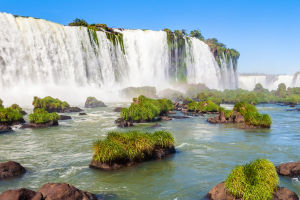
Welcome Lykkers! The Iguazu Falls, one of the world’s most breathtaking natural wonders, is a spectacular display of cascading water and lush rainforests.
Situated on the border of Argentina and Brazil, this massive system of waterfalls spans nearly 2.7 kilometers, making it one of the largest waterfall systems globally.
Iguazu Falls Vacation Travel Guide | Expedia
Video by Expedia
A Geological Masterpiece
The Iguazu Falls lie along the Iguazu River, which originates in Brazil and flows westward into Argentina before merging with the Paraná River. The name "Iguazu" derives from the Guarani language, meaning "big water," a fitting description of this grand natural feature.
The falls consist of 275 individual drops, varying in height from 60 to 82 meters. The most iconic section is the Devil’s Throat (Garganta del Diablo), a U-shaped chasm that plunges water with incredible force, creating mist clouds visible from miles away.
Location and Access
Iguazu Falls are part of two national parks: Iguazú National Park in Argentina and Iguaçu National Park in Brazil. Both parks are UNESCO World Heritage Sites and offer distinct perspectives of the falls. Visitors can access the falls from Foz do Iguaçu (Brazil) or Puerto Iguazú (Argentina), with each side providing unique vantage points and experiences.
Experiences at Iguazu Falls
1. Walkways and Trails:
The parks feature extensive walking trails and viewing platforms. The Argentine side offers a more immersive experience, with trails that take visitors to the top and bottom of the falls. The Brazilian side provides panoramic views, showcasing the entire expanse of the falls in one breathtaking frame.
2. Boat Rides:
For thrill-seekers, boat tours take visitors close to the base of the falls, offering a heart-pounding encounter with the cascading water. Prepare to get drenched as the boats navigate through the mist and currents.
3. Wildlife Encounters:
The surrounding rainforests are teeming with biodiversity, including jaguars, toucans, capuchin monkeys, and coatis. Birdwatchers will find the area particularly rewarding, as it is home to hundreds of species.
4. The Devil’s Throat:
A highlight of any visit is the Devil’s Throat, accessible via a walkway on the Argentine side. Standing above this roaring torrent is an awe-inspiring experience, as millions of liters of water rush past every second.
5. Helicopter Tours:
On the Brazilian side, helicopter rides offer a bird’s-eye view of the falls and the surrounding rainforest, giving a unique perspective of their grandeur.
Cultural and Historical Significance
The Iguazu Falls hold deep cultural significance for the Indigenous Guarani people, who believe the falls were created by a deity in an act of divine intervention. Today, the falls symbolize a shared heritage between Argentina and Brazil, fostering cooperation in conservation efforts.
Best Time to Visit
The falls are a year-round destination, but the best time to visit is during the wet season (November to March) when the water volume is at its peak. However, the dry season (April to October) offers better hiking conditions and less mist, allowing clearer views.
Preserving a Natural Wonder
Both national parks are committed to conservation, ensuring the falls and their surrounding ecosystems are protected for future generations. Visitors are encouraged to follow eco-friendly practices, respecting the environment and its inhabitants.
The Iguazu Falls is not just a sight to behold but a sensory experience that overwhelms and inspires. Its sheer size, roaring sound, and natural beauty make it a must-visit destination for travelers and nature enthusiasts. Whether you’re exploring the walkways, marveling at the Devil’s Throat, or simply soaking in the panoramic views, a visit to Iguazu Falls is an unforgettable journey into one of the Earth’s most remarkable landscapes.


